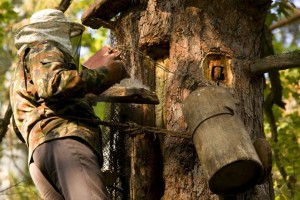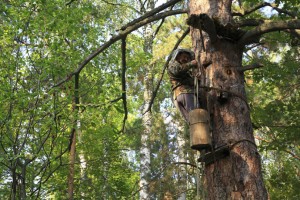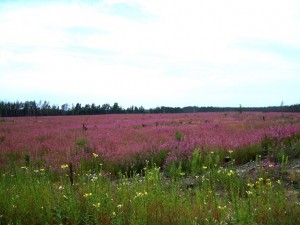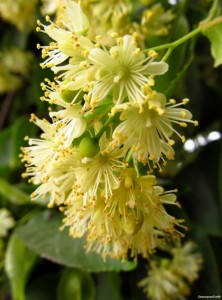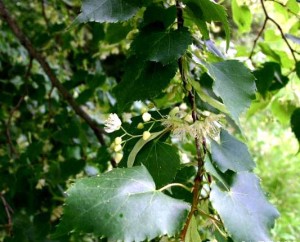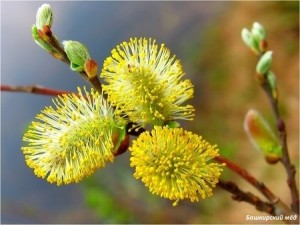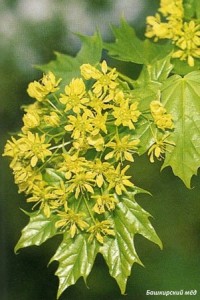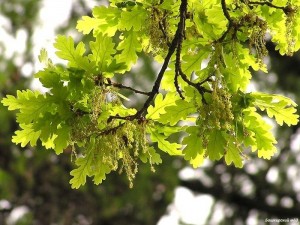Bashkir honey is harvested in the area of Outstanding Universal Value of Bashkir Ural which is recognized as a World Heritage by UNESCO.
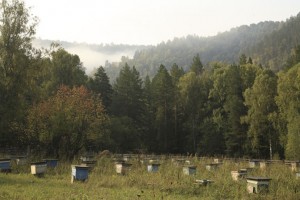 The area of Bashkir Ural
The area of Bashkir Ural
The natural and cultural complex “Bashkir Ural” is located on the western slope of the Southern Ural Mountains within the limits of the mountain forest zone of Bashkortostan. “Bashkir Ural” occupies the territory of approximately 45 thousand hectares (450 km2). The main part of the complex “Bashkir Ural” is slightly affected by the man-induced changes (the standard residential population density makes up 2.3 people per square meter) and consists of a specifically protected state wilderness area “Shulgan-Tash” and a part of a state entomological wildlife reserve “Altyn Solok”.
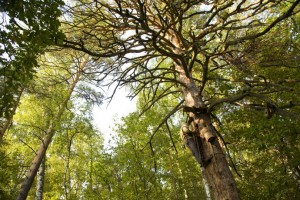 The eastern part of the complex “Bashkir Ural” is located at the junction of two massive wood biomes of European-type broadleaved forests and light-coniferous and Siberia-type parvifolia hemi boreal forests with grass layer. About 90% of the complex territory is covered with woods.
The eastern part of the complex “Bashkir Ural” is located at the junction of two massive wood biomes of European-type broadleaved forests and light-coniferous and Siberia-type parvifolia hemi boreal forests with grass layer. About 90% of the complex territory is covered with woods.
The land area of “Bashkir Ural” comprises a high diversity of wild landscapes: mountain rivers gorges, plateau-like areas, steep-sloped ranges, bottom-lands and water storage basins. Low anthropogenic effect, variety of land forms within the complex territory and the convergence of European and Siberian flora and fauna assemblages made conditions for a particularly high biodiversity of the complex. All of the above mentioned points have, in its turn, been making the given area attractive for a man to live since ancient times and defined the natural management culture and traditions.
The territory of the natural and cultural complex has represented a model of balanced interaction with nature practically ever since the time of its first human habitation. Basically, such types of minor forest products harvesting as livestock grazing, haying, wild harvesting and hunt were developed. The terrain of the natural and cultural complex presents itself as a site, preserving a unique ancient craft of the Bashkir people – wild-hive beekeeping, being an outstanding example of human-environmental interaction. Wild-hive beekeeping originated within the territory of the present-day Bashkortostan about one and a half thousand years ago. All the stages of beekeeping craft development can be viewed within the complex; Bashkir honey, produced by the Burzyan wild-hive bee, is acknowledged to be the best in the world in the view of its taste and the set of trace elements.
Nectar sources of Bashkir honey
Flowers
Notable for its beautiful amber, golden-amber and light amber colors, polyfloral Bashkir honey is characterized by aromatic flavor with a hint of emanation from meadow flowers such as dandelion, thyme,clover, alfalfa, sage, galium,yellow melilot and many others. The honey gives rich mouthfeel with attached pleasant aftertaste that satisfy everyone who is looking for unaltered gifts of Mother Nature.
Linden
Bashkiria is especially known for its linden honey. The fact is that in Bashkortostan there is zone of growing area of linden trees which extends on the territory of neighboring Chuvashia, Tatarstan where ubiquitous clean linden tree forests grow. Specifically in Bashkortostan it is located about 35% of all Russian linden trees! It is where the bees can collect pure white monofloral honey of special quality and outstanding properties. Flavor of honey reflects the richness of nature that belongs to this wonderful land. Linden honey is resistant to crystallization.
Small-leaved Linden
This tree (tilia cordata) is primary nectar source in Bashkir forest which gives up to 70 – 80% of marketable honey. In Bashkortostan,forest area with its predominance covers 933 hectares i.e. 17% of the forests of the country. Particularly high nectar producers are old-growth forests of linden trees. Nectar collection from this honey plant in a time characterized by great intensity but is not prolonged:only 10 to 15 days.
Accumulation of nectar in a hive begins with small weight gain of 0.5 – 0.7 kg then increases rapidly and at the height of bloom of a mid-size linden array reaches 5 – 8 kg or more then the weight gains are plummeting. The weather conditions during the linden bloom significantly affect the duration and intensity of nectar production by the flowers.
One hectare of linden tree in blooming time has 15 -17 million flowers that produce up to 500 – 700 kg elixir-like nectar.
Willow
Willow family is very large. In the spring forest goat willow (sálix cáprea) starts blooming first. It grows as a large separate tree blooming for 8 -12 days before leaves to unfold in late April to early May. Harvesting honey from goat willow gives life impetus to bees for the month of May but maple, willow and oak altogether give impulse to bee colonies to grow at an optimal rate. Hence, bees grown at that time constitute the main force of their decisive reproductive capacities for the whole season.
Norway maple
It blooms in the middle of May for 8-10days before leafing.
Oak
Oak often grows in a mixed forest in all forest areas west of the Urals and in the Urals. It blossoms in the second half of May to give the bees nectar.

